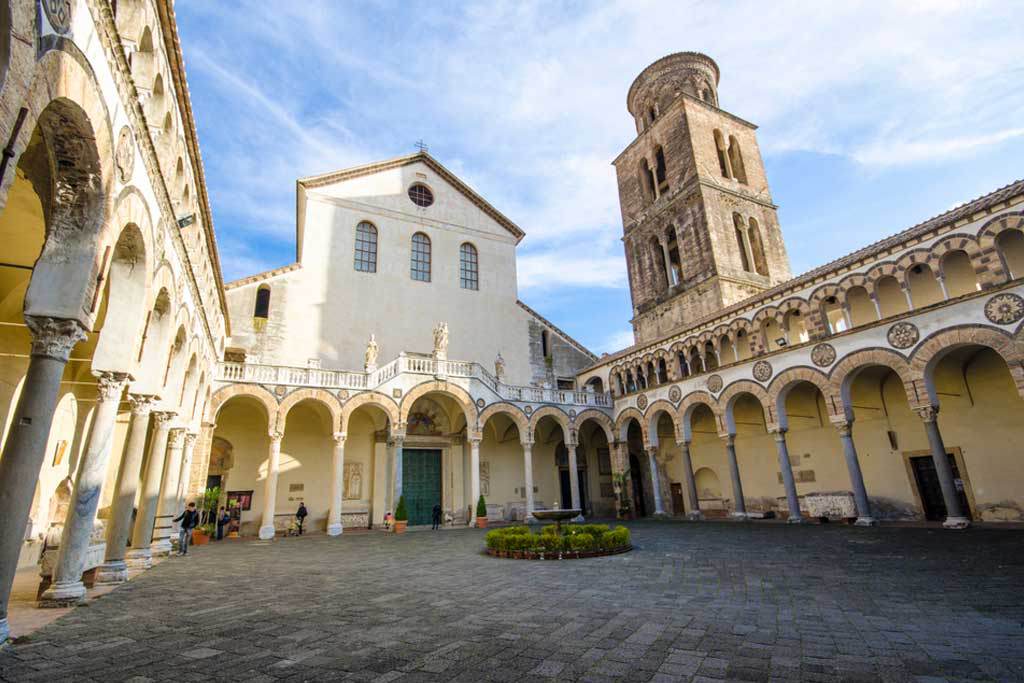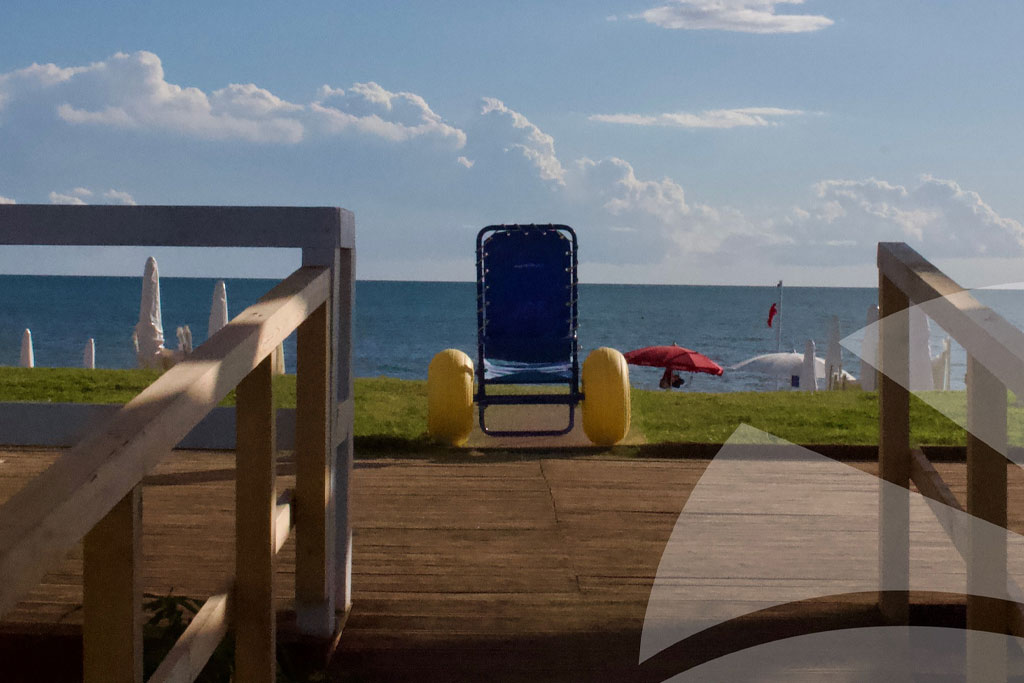The Metropolitan Primatial Cathedral of St. Mary of the Angels, St. Matthew and St. Gregory VII, more commonly known as the Cathedral of Salerno, is undoubtedly the most representative place of worship in the city of Campania, standing imposingly in the heart of its historical centre.
Its current structure is the result of Romanesque, Arab-Norman, Byzantine and Baroque contaminations that make it decidedly interesting from an architectural as well as a religious point of view.
Salerno Cathedral between history and legends
The current appearance of Salerno Cathedral corresponds for the most part to the post-earthquake Baroque renovation of 1688, but to go back to the beginnings of its construction, we have to go back more than six centuries. The basilica was commissioned by Robert Guiscard after the Norman conquest in 1076 and was built in just five years between 1080 and 1085. In fact, it was already consecrated in June 1084 by Pope Gregory VII, who had come to the city in exile to escape Emperor Henry IV, with whom he came into conflict over his opposition to episcopal investiture.
The pope’s relics are still preserved in the right aisle of the cathedral under the mosaic of St. Matthew inside the Crusaders’ Chapel. On the casket can be read an inscription in Latin that translated reads: ‘I have loved justice and hated iniquity: for this I die in exile’.
Today, the cathedral has a ground plan divided into a longitudinal body with three naves and a transept. It has an apse for each nave and a magnificent quadriporticus decorated with arches characterised by the presence of a portico supported by 28 columns with raised round arches. In the inner perimeter of the Romanesque quadriporticus (one of the very few Italian examples), several well-preserved Roman sarcophagi alternate under the vaults of the arches, while at its centre is an ancient baptismal font that replaced the monolithic fountain in Egyptian granite brought to Naples in the Villa Reale (now the municipal villa) in 1820 and recognised by all as the Paparelle fountain.
An ancient legend surrounds one of these sarcophagi, namely that of William II, nephew of Robert Guiscard. When William II died prematurely, his wife Gaitelgrima, in desperation, cut off his long hair and placed it on her late husband’s sarcophagus. Legend has it that every year on 4 August a golden butterfly flies into the quadriporticus and lands on the sarcophagus. The butterfly then suddenly disappears when the ghost of the sad Gaitelgrima arrives and repeats the ritual of cutting her hair.
The large four-sided portico is accessed via a double flight of steps, at the top of which stands the Porta dei Leoni (Lions’ Gate), rebuilt after the 1688 earthquake and also the protagonist of an ancient legend. It is said that during a Saracen invasion the two statues placed at its base (a lion symbol of strength and a lioness.
On the south side of the four-sided portico, the Norman bell tower rises very high: four large cubes ending in a tiburium are superimposed, reaching a height of fifty-two metres with a base of about 10 metres on each side. At sunset it is illuminated, acquiring a decidedly evocative charm. The cathedral bells are the symbol of the different architectural contaminations of the tower and the cathedral. There are eight in total, differing in size and belonging to different eras ranging from the 16th to the 19th century.
The bell tower is not the only treasure of Salerno Cathedral. Once past the quadriporticus and through the imposing bronze double doors, you enter the cathedral, which has undergone several restorations over the years, the last of which was in 1931.
The floor is largely decorated with mosaics, especially in the transept area, and the two amboes of the nave are also extensively decorated, where sculptures representing elements of the animal world with symbolic significance are once again to be found amidst exquisite ornamental motifs: eagles, snakes, bulls and lions.
The beauty of the cathedral extends far beyond the long aisles of its church. Through a small door in the sacristy, one enters the Chapel of the Treasure, a small room of about 36 square metres where the treasures or relics of the holy martyrs of Salerno are kept. The chapel has a fresco on the ceiling depicting the Paradise of Salerno or the saints linked to the city, including: Matthew, Fortunatus, Gaius, Ante, whose statues are paraded in procession every 21 September, the day dedicated to St Matthew, the city’s patron saint.
The chapel can be visited on the 21st of each month only in the morning, while the rest of the cathedral is open to the public every day from 8.30 a.m. to 8 p.m. on weekdays and from 8.30 a.m. to 1 p.m. and then from 4 p.m. to 8 p.m. on public holidays.
The crypt, the heart of Salerno Cathedral, guards the remains of the beloved St. Matthew.
The crypt forms the core of the cathedral. The ceiling is completely decorated with frescoes depicting both scenes from the Gospel and episodes from Salerno life.
All the columns of the crypt are encased in marble dating back to the mid-18th century, while the walls feature twenty-one statues representing John the Baptist and the first twenty bishops of Salerno.
The crypt is right in the centre of the Cathedral, in the basement, and is a true jewel of Baroque architecture. Its current appearance is due to the 12th century restoration and sees at its centre the tomb with the relics of St Matthew, representing the Sancta Sanctorum around which all the other elements of the space revolve. The tomb of the saint consists of a large marble canopy bearing the coats of arms of the Bourbons, on which a bronze, two-faced statue of the Evangelist towers.
There is no scientific explanation as to why the sculptor Michelangelo Naccherino chose to make two faces of the saint but, of course, there are various interpretations.
Matthew, before becoming an apostle of Jesus, was a tax collector (he is in fact still the patron saint of the Guardia di Finanza and bankers).
A first interpretation therefore links St Matthew’s double face to his double life before and after his encounter with Jesus.
A second interpretation harks back to the cult of Janus Bifrontus, the Roman god who can see both the future and the past. Many buildings dedicated to St Matthew throughout Italy were, in fact, built on top of the remains of ancient temples dedicated to the Roman god.
The double-faced characteristic of the saint has also been and still is reflected in parochial slang. It is not uncommon for someone from Salerno to be mocked by someone from Salerno saying ‘double-faced Salerno like St Matthew!’, thus linking the peculiarity of the statue to a hypothetical duplicity in the character of the saint and the citizens.
Beyond any possible interpretation, the only certainty is the love and devotion of the people of Salerno to their patron saint. The procession on 21 September attracts thousands of people every year, including dozens and dozens of Salernitani emigrants. The three silver statues of the martyrs Gaius, Fortunatus and Ante, and that of St Matthew, are carried on the shoulders of a large group of bearers who scrupulously follow the directives and pace of the group leader, ending the procession with a real race up the double flight of steps at the entrance to the cathedral, which has traditionally become an integral part of the procession itself.
It is a great feast for everyone, combining the sacred and the profane, devotion and folklore, and involving all the main streets of the city centre amidst music, fireworks and the typical sandwiches stuffed with spleen.
Salerno’s cathedral is in its oldest historical centre in a pedestrian area but not far from wide streets (e.g. the trincerone) where you can park your car.
It is very close to the ancient Temple of Pomona and not far from another masterpiece of Baroque architecture, the Church of San Giorgio.
In the alleyways around the cathedral, various craft workshops alternate with bars, pizzerias and nightclubs that are increasingly animating the city’s nightlife, enveloped by the incredible suggestion of the cathedral’s beauty and protected by the love of St. Matthew.
‘Salerno is mine and I defend it’ are the words attributed to the saint on the occasion of saving the coast from a Saracen invasion.
There is no certain proof of the veracity of this phrase, but no Salerno resident has ever questioned or will ever question the patron saint’s love for his city.




